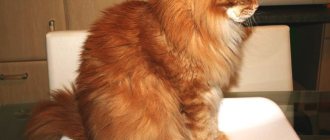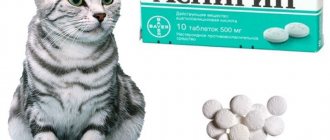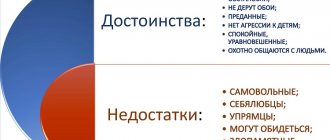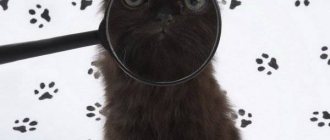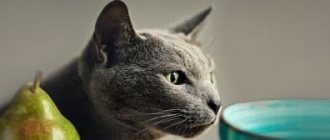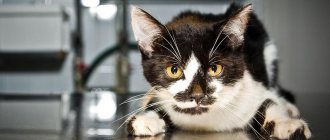History of the British Shorthair cat
British Shorthair Cat
Over the years, it is impossible to find documentary evidence of the first appearance of cats in the British Isles. However, researchers suggest that domesticated animals were brought there by Roman conquerors. The legionnaires, of course, did not keep them as furry friends - someone needed to protect the provisions in the holds from the attacks of ship rats. True, those rodent hunters bore little resemblance to today’s round-faced and well-built individuals; their physique was closer to the graceful and long-legged Egyptian animals.
But the free feline nature took its toll - and some of the small predators brought by the invaders moved from the decks to solid ground, and there, over time, they met wild relatives who enriched the gene pool.
For centuries, short-haired purrs lived side by side with peasants, receiving a little milk and a roof over their heads for their contribution to the fight against mice. No one, of course, cared about selecting kittens based on coat color, ear shape and tail length, so the appearance of the breed was formed naturally. It must be said that the attitude towards these cute creatures was often not just indifferent, but even hostile, while dogs were considered true friends, worthy of sugar bones and a place by the fireplace.
It was only in the second half of the 19th century that the British realized that their pets had many unique and attractive characteristics that needed to be strengthened and developed. In the Victorian era, being the owner of a cat became not shameful even for a representative of high society. The popularity of mustachios was greatly promoted by the original and witty drawings of the famous English artist Louis Wain. A talented graphic artist created a whole universe in which anthropomorphic cats play golf and bridge, go on picnics, read newspapers, have Christmas parties, sledding, play music, relax on the beach... In addition, already at the dawn of the development of photography, enthusiasts of the new art realized that how beautiful furry creatures look in the frame. In a word, the ice was broken.
British blue color (gray, classic), which is standard for the breed
British cat kitten
On July 13, 1871, the world's first professionally organized cat show was held in London with great success. Harrison Ware, with the support of the then manager of Crystal Palace, invited 170 event participants and their owners to the former World's Fair pavilion. He also developed competition regulations, a system for awarding points and determining winners in various categories. Visitors were surprised to discover that well-groomed and well-fed cats not only look charming, but also behave like real aristocrats. The next morning, the front pages of the capital's respected newspapers were adorned with portraits of the award winners, including 14-year-old blue tabby Old Lady. By the way, it was the blue color that was considered the only correct color for British shorthairs in the last century.
After the exhibition, the once unnoticed street animals gained popularity. A breed standard, amateur clubs and the first kennels appeared. However, in the last decade of the 19th century, Great Britain was swept by the pan-European fashion for Persian cats. On this wave, during the First World War, breeders introduced the British Longhair. Experts still cannot say with certainty whether a fixed spontaneous mutation took place or whether the breeders simply used “foreign” genes in breeding.
With the outbreak of World War II, the already unfavorable situation for shorthairs became truly catastrophic. Animals, like people, died en masse under German bombing, and the policy of food austerity left no chance of maintaining nurseries. In the post-war years, the few surviving British cats were actively crossed with representatives of various breeds to produce offspring: Russian Blue, Chartreux, Persian. Due to the large percentage of mixed blood, the breed was classified as a hybrid for a long time and therefore was not registered by leading regional and world felinological organizations. The American Cat Association distinguished American Shorthairs from Old World cats in 1967, listing the latter under the name "British Blue." The ACFA accepted the breed in 1970, and The Cat Fanciers' Association (CFA) recognized the breed in 1980.
British cat of smoky color
British color point cat
Blue cat
A true British Blue cat has soft, fluffy fur and is somewhat reminiscent of a teddy bear. Distinctive features include huge round eyes of amber, copper or orange color and soft short or long fur of an even gray-bluish color. In purebred cats, the hairs are colored from the base to the very tips . Often spots and impurities in color can cause culling.
The British have a powerful, strong and muscular body of medium size. Males are larger in size than cats. The legs of the British are short and dense with rounded soft paws. The tail is thick and not fluffy.
A fairly massive round head, a wide chest, a short and strong neck, wide and slightly rounded ears, very dense hair, a short and straight nose - these are the main characteristics of the appearance of the British Blue cat. Fold-eared representatives of this breed have ears tightly pressed to the head . The appearance of such cats looks especially cute and touching.
British Blue cats have excellent health and are one of the natural breeds.
In addition to short-haired blue British cats, there are also long-haired ones. But in Russia they are not so common. The average weight of a representative of this breed ranges from 4 to 6 kg .
Personality of the British Shorthair cat
I love scratches!
The British cat is a rare example of complete correspondence between appearance and inner world. In character, these plush hulks truly resemble your favorite soft toys from your childhood. And the special “smiling” expression of their round faces once made them a real prototype of the Cheshire Cat from the stories about Alice’s adventures. Good-natured and unpretentious companions fit perfectly into the life of almost any family, without requiring absolute attention to their person.
However, the latter does not mean that they are indifferent to their owners. On the contrary, representatives of the breed are very attached to “their” people and often move with them from room to room, but do this unobtrusively. Fluffy intellectuals love affection, however, they prefer to receive it on their own terms - they will happily sit next to you on a soft sofa and will purr contentedly in response to stroking, but they will not be particularly enthusiastic about the idea of lying on your lap or being in a gentle embrace. Personal space for the subjects of the British Queen is not an empty phrase!
The cat will spend the time that household members spend at work or study not on organizing a pogrom in the home, but on peaceful sleep or contemplating the surroundings from a window with a wide windowsill. If some trinkets dear to your heart suffer from his paws, it will happen completely by accident. The fact is that short-haired cats are not very graceful. Their cute clumsiness is also quite consistent with the image of a clumsy bear cub.
Cat fight
Despite the fact that for a comfortable life, the British do not need to have a playmate, due to their easy-going and friendly nature, they have no problem letting other pets into their close social circle: cats, dogs of different breeds and sizes, reptiles and (despite strong hunting instincts) rodents, birds. They get along well with children - provided that the kids do not overdo it in showing affection or treat them rudely.
In addition, British will not cause misunderstandings with neighbors, even if the walls in the house are very thin. Of course, little kittens and teenagers love noisy games. But with the onset of maturity, in English they are reserved, sedate and silent.
However, British shorthair cats can from time to time surprise their owners with unexpected outbursts of activity, turning at such moments into carefree rogues, rushing around the house at great speed after a real ball or imaginary prey.
I am extremely dissatisfied!
I think they suit me better than you
Raising British cats: features
Retraining an adult cat is not easy. He is stubborn, self-sufficient, and this feeling is inherent in him from birth. Education needs to be done from early childhood at the age of 4 months.
Parenting rules:
- First, the cat is shown the house, a place to sleep and where the tray is located. Then they are introduced to family members.
- The cat should not be allowed to eat from the table. He should have his own bowl.
- The British are gradually accustomed to hygiene procedures. He must also learn how to care for his fur on his own.
- To prevent him from sharpening his claws on the sofa and other things, he is periodically brought to the scratching post.
- You cannot yell at or hit a kitten if it behaves badly. It is enough to scold him in a stern voice, to tell him how disobedient and bad he is. Eventually, he will understand what he did wrong and change his behavior.
Be sure to read:
Lilac British cat: features of the breed’s appearance, characteristics, behavior, care
Care and maintenance
British cats do not cause much trouble for their owners. Their dense and thick fur practically does not tangle or mat, so to care for the fur, it is enough to go through the fur coat with a special brush once or twice a week and remove fallen hairs. During periods of seasonal molting (spring and autumn), the procedure must be carried out more often, otherwise furniture and clothes will become unexpectedly fluffy.
Brushing a British kitten
Ears are cleaned once every two weeks, it is advisable to wipe eyes with cotton swabs soaked in boiled water once a week.
It makes sense to give your pet fur-dissolving medications from time to time, since when licking, some of the thick fur gets into the stomach and can cause serious health problems.
Frequent washing of a cat is undesirable, since the natural fat layer is a barrier to many infections and bacteria. If for any reason the animal is so dirty that washing cannot solve the problem, be sure to use gentle products recommended by veterinarians and make sure that water does not get into the ears - this can cause inflammation of the ear canal.
Time for yogurt
The immune system of the British allows them to take long walks outside without health consequences when the air temperature does not drop too low, but in large cities heavy traffic, dog attacks and the actions of intruders pose a serious danger, so keeping them at home would be preferable.
This breed is prone to obesity, which is the root cause of a number of diseases. Relatively low physical activity of adults leads to rapid accumulation of excess weight. A balanced diet and strict adherence to recommended serving sizes will help avoid problems. When eating natural foods, do not forget about the need to take vitamin and mineral supplements.
Regular preventative examinations at the veterinary clinic, timely vaccinations and regular dental and ear care will help ensure a good standard of living for your pet. Please note that all reputable breeding and cat owner organizations strongly oppose the practice of declawing and tendonectomy (a surgical procedure in which part of the tendon responsible for the claw release mechanism is removed). The most humane ways to protect your furniture and wallpaper is to carefully trim off the sharp ends and train them to use a scratching post.
Origin of the British cat breed
There are several versions explaining the origin of the British cat breed. According to one of them, the history of the origin of the British cat is connected with the history of the conquest of Britain by Rome - supposedly the Romans brought with them Egyptian cats, which over time adapted to their new habitat, acquired thick hair with excellent protective properties and, thanks to their unsurpassed hunting talent, became valuable pets pets.
This is confirmed by ancient mass graves of cats discovered by archaeologists in the cities of Badbury, Gassage, Danbury and All Saints.
According to another version, the history of the British cat is closely connected with the history of the French cat, the Chartreuse. These animals probably came to the territory of modern Europe from South Africa during the Crusades. At first they were bred by Carthusian monks in the Chartreuse monastery, and only then sailed to the British Isles along with French sailors, for whom they “served” as rat catchers.
This hypothesis is confirmed by the extraordinary similarity of the two breeds, the difference of which can only be seen by professional felinologists.
Health and disease of the British Shorthair cat
The health of the breed is not of serious concern to specialists. But breeders who claim that British Shorthairs are generally not prone to disease are shamelessly disingenuous. Yes, there are no diseases specific to the British cat, however, there are those to which any purebred cat is susceptible, including those caused by genetics, therefore, before allowing animals for breeding, appropriate medical studies must be carried out.
Neighbor Watching
Hypertrophic cardiomyopathy is a thickening of the wall of one of the ventricles (usually the left), which leads to cardiac arrhythmias, heart failure and death. When detected at an early stage and lifelong use of a whole complex of drugs, the development of the disease can be significantly slowed down. Animals with this diagnosis cannot participate in breeding.
Hemophilia B - reduced blood clotting, as a result of which any injury is fraught with serious blood loss or extensive internal hemorrhage. Inbreeding increases the risk of disease. There is no complete treatment; sick animals are given blood transfusions, and to combat anemia and stimulate hematopoiesis, iron supplements, hepatoprotectors, and vitamins B6 and B12 are prescribed. Gene carriers and individuals suffering from hemophilia are excluded from breeding.
What do you allow yourself!
Polycystic kidney disease is the formation of fluid-filled hollow tumors, which disrupts the normal functioning of the excretory system. A typical disease of Persian cats, with which the British suffered from hybridization. At the initial stages there are no noticeable changes in the pet’s behavior, so it is often diagnosed only in an advanced stage. There is no effective therapy. If the cysts are single, they can be removed during surgery, but in case of serious damage, only drug treatment is possible, which will prolong the animal’s life by several months or years.
Gingivitis is an inflammation of the gums that affects the ligaments and bones. Without proper treatment, tooth loss occurs and infection spreads through the bloodstream.
Fur coat color
Unlike its distant ancestors, who had a variegated, multi-colored color, the modern British dog has an evenly and uniformly colored coat. Behind this lies many years of work by breeders who managed to achieve uniformity at the cost of very great effort. See also photos of British cat colors.
The most popular and at the same time the most exotic options are pure gray and gray with a blue tint. They also differ in that blue wool feels softer and smoother to the touch than wool of other colors.
Other options include:
- White color with blue eyes.
- Chinchilla - silver with black haze and green eyes.
- Silver with copper eyes.
- Blue with orange eyes.
- Smoky eyes with a yellow tint.
These are the main shades of pile according to the standards.
There are many others:
- Two-tone, white color combined with any other.
- Marble color.
- Tortoiseshell.
- Striped.
- Siamese type - light body with dark markings on the face and other parts of the body.
All these types are not defects, but only variants of the breed norm. This color of the pile suggests an eye color identical to the blue color.
Although the modern Briton has moved far from his Persian ancestor, the color of the pile in any case reminds of his origin. It is worth taking into account that the color of the paw pads and nose matches the shade of the fur coat.
How to choose a kitten
Let me in!
Like all purebred cats, real British Shorthairs are not sold in subway passages, at bird markets or through free advertisements on the Internet! The saddest consequence of such a “profitable” acquisition will not even be that the fluffy ball will grow into a cat completely different from the British one. As an inheritance from unknown parents, he can receive a whole bunch of congenital diseases, and the lack of veterinary support and non-compliance with the nutritional rules of a nursing mother and babies is the cause of poor immunity and acquired diseases.
You need to devote enough time to choosing a cattery, because only breeders who value their professional reputation, provide complete and reliable information about the pedigree, and care about the well-being of the cat and her kittens. Even if your goal is not a show-class British breed, pay attention to the success of “graduates” at regional and international shows - this is a good indication of healthy genetic lines.
A responsible breeder does not hand over kittens to buyers that are under 12-16 weeks of age. Until this time, you can reserve the baby you like, but he needs socialization in the company of brothers and sisters, learning the intricacies of cat life from his mother and, of course, timely vaccination, which will provide protection against many dangerous diseases.
The little Briton should be active and playful, have a good appetite and react to human society without fear.
Black pages of history
Alas, the glorious history of the British breed is overshadowed by a black streak. Like other cats that lived in Europe, British tailed cats were subjected to severe persecution in the Middle Ages. They were declared minions of the devil, burned at the stake and subjected to the most sophisticated tortures.
People who were disliked by the intriguers also suffered along with them. Thus, in 1307, the bishop of the city of Converti was accused of worshiping a black cat, and during the trial, this accusation extended to members of the Templar Order.
However, everything comes to an end someday, and fortunately, bad things too. Already in the 30s of the 17th century, the writer Daniel Defoe noted that it was a rare English family that did not keep a cat. And how could it be otherwise - the devil is the devil, but someone has to catch the rodents!
Photos of British kittens
Types of colors
Selection work on representatives of the British breed, involving various bloods, has led to a variety of both colors and breed types. If initially the British had short hair with a thick undercoat, then crossing with the Persian cat made it possible to obtain semi-long-haired animals. The colors of British longhair cats correspond to the colors of shorthair cats.
Many people only think of Britons as smoky, blue or tabby cats and don't even realize how many colors the breed has. Even a pair of quite ordinary parents can produce a kitten of a rare color.
To organize the variety of colors of British cats, they are divided into types and groups according to color, pattern and method of pigmentation.
Types of colors of British cats:
- solid (or plain);
- typed: smoky, veiled, shaded;
- gold;
- silver;
- tortoiseshells;
- color point;
- particolors: harlequin, bicolor, van, mitted;
- tabbies: spotted, striped, marbled, ticked.
A table of the colors of British cats will help you imagine all the diversity.
How much does a British Shorthair cat cost?
The price of a kitten traditionally depends on the fame of the nursery, title status of the parents and compliance with breed standards.
But in the case of British Shorthairs, color also matters. The most common blue and chocolate with copper-yellow eyes are also the most affordable in their class. But unusual individuals, for example, a blue-eyed color-point or a chinchilla with emerald eyes will cost much more. The British, who are suitable for life in a loving family, but do not have the makings of a future champion or qualities interesting for breeding, can become yours for 3-10 thousand rubles. Further, the price increases depending on pedigree and personal prospects. The cost of show-class kittens reaches 35-50 thousand rubles.
"Conquest" of the world
Overseas, British cats also went through a difficult journey - the first Briton was exported to America back in 1901, however, the CFA recognized the British Shorthair as an independent breed only in 1980.
Fortunately, today all the misunderstandings are behind us - the British Shorthair breed is recognized by all felinological organizations. There are probably thousands of nurseries where British dogs are bred all over the world. Breeders are working on the emergence of more and more new colors - today British cats can no longer be only blue.
With all this, they retained their best features: the recognizable appearance of respectable aristocrats, excellent health, excellent hunting abilities and a calm, self-possessed character.
Interesting Facts
What breed is the Cheshire cat? This question is asked by many readers of L. Carroll's works. Now you know the answer - the famous Cheshire cat was British, and its prototype is a cat of this particular breed.
Britons are called positive and optimistic cats. And all because they are the only cats who can smile. It's all about the chubby cheeks and protruding tongue.
The British Shorthair cat is often mistakenly called Scottish Fold. The fact is that Scottish Folds have a variety of cats with straight erect ears - straights, which are very similar to the British. But still these are completely different breeds.
Do you want a cat with a rare and interesting color? Then you need a British one. Today, there are officially 62 colors of the British Shorthair cat - in such a variety, everyone will find a kitten not only of the desired color, but also shade.
